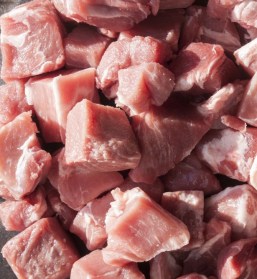You’ve likely heard the old saying, “Laws are like sausages, it is better not to see them being made.” Given the way Congress is behaving these days, however, we think comparing the two is just unfair. For one, you can make sausages pretty easily at home, whereas making laws at home may result in handcuffs. For help understanding how to make sausage, we’ve reached out to Sam W. Edwards III, President of S. Wallace Edwards & Sons. Based in Surry, Virginia, the Edwards family has been selling all-American meat products for almost 90 years. In other words, Mr. Edwards knows what he’s talking about.
Finding a Meat Grinder

Selecting Meat
Theoretically, you can make sausages out of any type of meat that you want — if you’re a hunter, for example, you might consider turning your quarry into delicious sausages. That said, you can never go wrong with pork sausage. As for the proper pork cut, Edwards suggests Boston butt (also known as pork butt). This cut is actually located on the hog’s shoulder, so stop snickering. Bacon trimmings, which come from pork belly, are also great for sausages.
“Our lean-fat mixture is targeted to 72 to 75% lean,” says Edwards. “For a 250-pound batch, for instance, we’d use 150 pounds of butts to 100 pounds of bacon trimmings, which will get you to about 72% fat.” Since you probably won’t be making 250 pounds of sausage, just keep the 3:2 butt-to-trimmings ratio in mind. You can probably get what you need from a grocery store meat butcher, but you’re better off visiting a bonafide butcher.
Freezing

Once you bring home the bacon (literally), you’ll have to freeze it until you can make your sausages. The trick is to cut the meat into pieces, wrap it in plastic and aluminum foil, and freeze it quickly. “A lot of people make the mistake of taking a 5 lb. glob of meat and sticking it in a freezer where there’s no airflow, and it takes about 4 or 5 days for the meat to freeze,” says Edwards. “It’s better to put it in a freezer with the temperature at zero or colder.” This is assuming that you don’t have the time to grind the meat right away — ideally, you would make your sausage as soon as you get home.
Related: The Manual’s Quick Reference Guide to Smoking Meat
Grinding

Seasoning
Seasoning is key for truly delicious sausages. “We don’t use any artificial ingredients, no MSG,” says Edwards. “We like black pepper, red pepper, white pepper, salt, and the key ingredient for us is real sage.” Other tasty ingredients to consider are sugar, oregano, garlic, and chili powder.
There’s a whole lot of recipes you can follow online. If you’re feeling adventurous, however, you can just let your creativity run wild. Just make sure to test the taste by occasionally cooking up a small patty of seasoned meat. Edwards uses about 5.5 pounds of seasoning to 250 pounds of meat. Since you probably won’t be making that much sausage, just go for a meat-seasoning ratio of about 1:50. Be sure to knead the meat until the seasoning is well incorporated.
Casing

All you have to do is slide the casing onto the horn, put the seasoned meat in the grinder, and start grinding. “As the grinder pushes the sausage through the horn, you need to keep a little bit of pressure on the casing with your hand,” says Edwards. “You should also tie off the end to make sure the meat doesn’t squirt off the end of the sausage casing.” Take your time with it, and be careful not to overstuff the casing. It’s possible to perform the grinding and casing by yourself, but it’s also a good excuse to enlist a buddy’s help. In fact, you might invite several buddies and throw a “sausage fest.” Er . . . on second thought, maybe not.
Storage
After casing the meat, squeeze and twist it into links of your desired length. Gently puncture the casing of each link to help relieve pressure and prevent bursting. Ideally, you would cook and eat the sausage right away; that said, your doctor probably wouldn’t like you eating 20 sausages at once. “Sausages have a shelf life in the neighborhood of 4 or 5 days refrigerated, assuming your refrigerator is about 37, 40 degrees,” says Edwards. “If you’re not going to eat the sausage within the first 2-3 days, I suggest wrapping it in saran wrap first, then foil, and putting it in the freezer in two-serving batches.”
Making sausages at home is not only fun and easy but it’s also a great way to impress your friends. It’s hard to beat fresh-made sausage in the morning. Or the afternoon. Or the evening. Or at 3am. Sausages are always good, and knowing how to make sausage yourself is a glorious power. Wield it responsibly.
Are you looking to try some high-quality, professionally made sausages? S. Wallace Edwards & Sons sells sausages, ham, bacon, and many other meat products at their online store.




